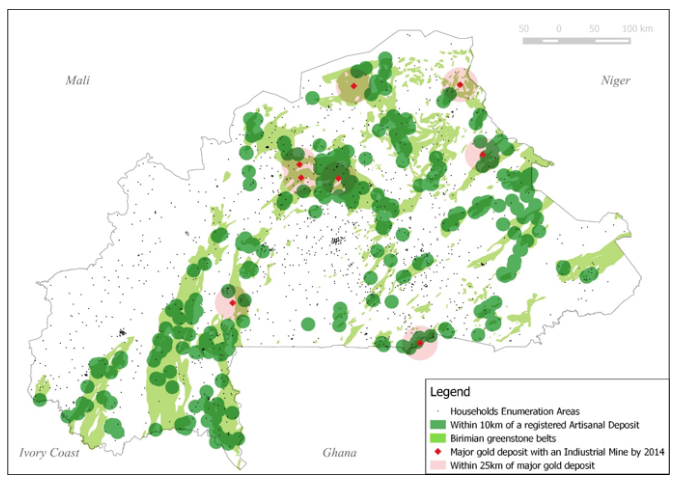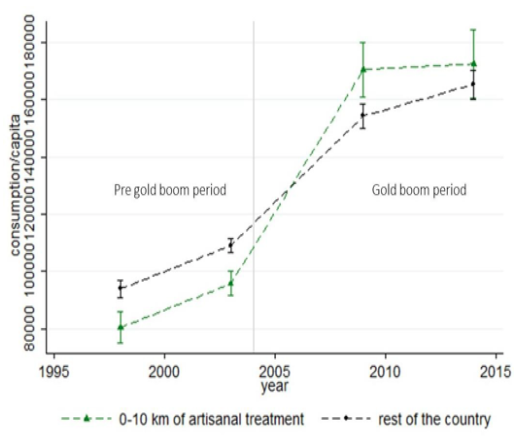
While the state benefits more from industrial than artisanal mining, only artisanal mines increase the consumption of local populations
More than 100 million people depend directly on artisanal mines for their livelihood. These mines produce around 20% of the minerals we use and employ 90% of the extractive sector workforce (World Bank 2009, Buxton 2013). The remaining production and workforce are related to industrial mines – a modern and capital-intensive activity.
Artisanal gold mining is labour intensive. It encompasses artisanal and small-scale mining (ASM) activities usually relying on local labour and rudimentary tools. Industrial mines are modern high-tech enterprises relying on international capital and overwhelmingly foreign workers.
Gold mining in Burkina Faso: Traditional versus modern
In Burkina Faso, artisanal mines are managed in public commons, while the production area of industrial mines is enclosed. The establishment of an industrial mine thus substantially increases capital intensity and productivity, while privatising natural resources. This setting represents a classic case of a traditional activity – low in productivity, but accessible to all – being replaced by a modern activity.
Other examples include switching from traditional to modern agriculture or replacing a communal forest with an oil field or any other type of heavy industry with clear property rights (often held by a foreign firm). Each of these replacements entails major local changes and affects the expected and actual revenue sharing.
Local population gains versus national gains
In a recent paper (Bazillier and Girard 2020), we highlight that the competition for land between traditional artisanal and modern industrial mining activities corresponds to different gains for local populations and the national government. While they ultimately produce the same good (gold), the two mining techniques differ significantly.
We are able document the causal local effects of both artisanal and industrial mines thanks to two sources of variation that make Burkina Faso an ideal case study:
- The geography of mines. Gold reserves are scattered all over the country, so that some people live close to an artisanal or industrial mine while others do not (see Figure 1).
- The gold boom. The price of gold increased four-fold over the course of the 2000s, so that the benefits of digging for gold have changed over time for both artisanal and industrial mines. We are able to exploit this quasi-natural experiment thanks to detailed household surveys collected both before and after the increase in the price of gold.
Figure 1 Location of households’ enumeration areas, artisanal and industrial mines

Our findings
Impact on local consumption
What happens to people who live next to artisanal mines when the price of gold increases? They consume more. Consumption is the best proxy for income in a developing country context, so this increase in consumption is good news. Figure 2 shows how local consumption near artisanal mines increased during the gold boom.
Figure 2 Evolution of consumption of households living close to artisanal mines versus those in the rest of the country during periods of low and high gold prices

A back-of-an-envelope calculation suggests that a high gold price translates into five additional cents (in euros) of consumption per day per person living near an artisanal mine. This additional consumption may seem small at face value but five cents is a big increase in relative terms, corresponding to a 10% increase in consumption.
Without underestimating the negative side effects artisanal mines may have, this first quantification of the economic impact of artisanal mines within the economic literature allows one to qualify their bad reputation (Cust and Poelhekke 2015).
In sharp contrast with the local impact of artisanal mines, the opening of industrial mines does not improve local consumption. Thus, despite the scale of production, the local impact of industrial mines is not always guaranteed, even though local content policies, encouraged by the World Bank, may be successful in some contexts (Aragón and Rud 2013).
Impact on the state
In 2014, artisanal mines contributed 5% of the value of their declared production to the revenues of the state of Burkina Faso (ITIE 2016). This contribution is small in both absolute and relative terms: the declared production of artisanal mines was only 1.4 tonnes in 2014, with most of the actual production being smuggled out (mainly through Togo) (Guéniat and White 2015).
In contrast, industrial mines contributed 19% of the value of their production to the state budget (ITIE 2016). With industrial mines producing 25 times more gold than artisanal mines in 2014, they represent a significant contributor to the country’s public finances. In 2014, their contributions represented 8% of the national budget.
Who wins?
How do the economic contributions of industrial and artisanal mines compare? Economic flows attributable to artisanal mines represented 58% to 158% of the economic flows attributable to industrial mines in 2014. To calculate these numbers, we add up for each activity the estimated local consumption effect and the contribution to the state budget.
Where the mines differ significantly is in who earns and spends the money. Virtually all the contribution of artisanal mines that we measure is through local consumption. Conversely, since we observe no change in local consumption after the opening of industrial mines, we assume the entire contribution of industrial mines is to the state budget. This assumption allows us to obtain an order of magnitude that should be reasonably close to reality.
Conclusion: Considering the impact on local populations
As is the case for many traditional activities, artisanal mines support local consumption while posing formalisation and taxation challenges for their host countries. Industrial mines, on the other hand, contribute to the national budget; however, as of 2014, they did not appear to improve local consumption.
These observations may help us to understand why local populations may protest the construction of industrial mines (Capitant 2017). Our results call for more research on and attention to the cohabitation of both activities.
References
Aragón, F M and J P Rud (2013), “Natural resources and local communities: Evidence from a Peruvian gold mine”, American Economic Journal: Economic Policy 5(2): 1–25.
Bazillier, R and V Girard (2020), “The Gold Digger and the Machine. Evidence on the Distributive Effect of the Artisanal and Industrial Gold Rushes in Burkina Faso”, Journal of Development Economics 143.
Buxton, A (2013), "Responding to the challenge of artisanal and small-scale mining. How can knowledge networks help?", IIED, London.
Capitant, S (2017), “Les ’populations’ à l’assaut des mines: économie morale de la contestation minière au Burkina Faso”, in M Leclerc-Olive (ed.), Anthropologie des prédations foncières: Entreprises minières et pouvoirs locaux, Éditions des Archives contemporaines
Cust, J and S Poelhekke (2015), “The local economic impacts of natural resource extraction”, Annual Review of Resource Economics 7(1): 251–268.
Guéniat, M and N White (2015), A Golden Racket: The True Source of Switzerland's “Togolese” Gold, Berne Declaration, Geneva.
ITIE (2016), L'Initiative pour la Transparence dans les Industries Extractives (ITIE) Burkina Faso.


